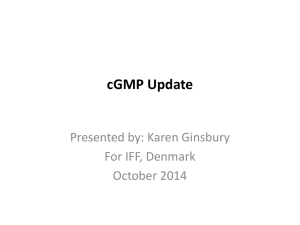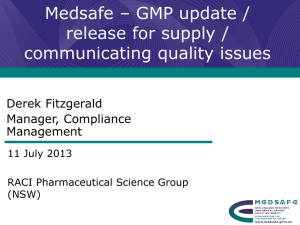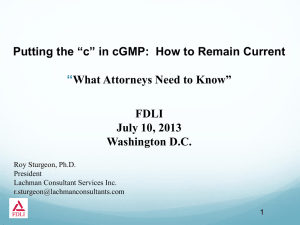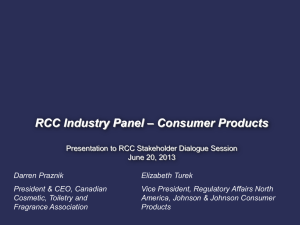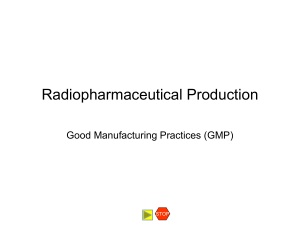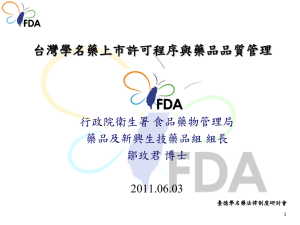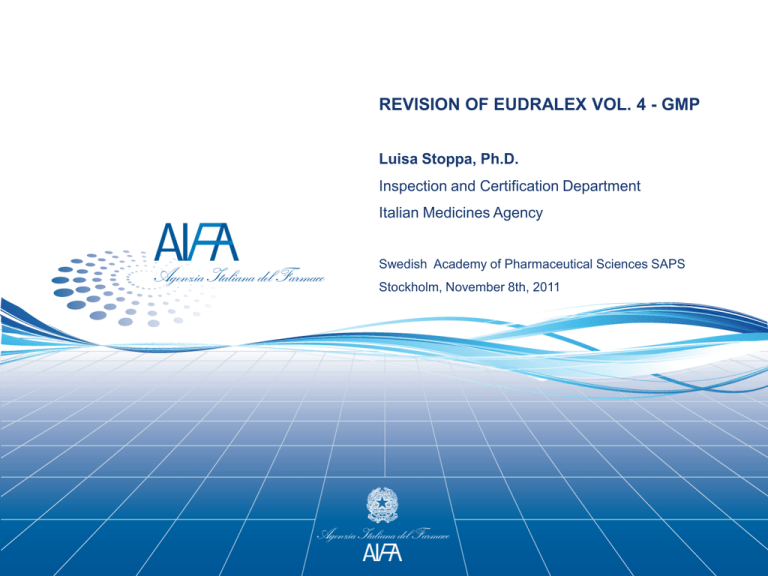
REVISION OF EUDRALEX VOL. 4 - GMP
Luisa Stoppa, Ph.D.
Inspection and Certification Department
Italian Medicines Agency
Swedish Academy of Pharmaceutical Sciences SAPS
Stockholm, November 8th, 2011
® All rights reserved
Agenda
1. GMP – history
2. GMP – definition
3. GMP - structure
4. GMP – updates
5. GMP – next updates
6. GMP – under discussion
® All rights reserved
Agenda
1. GMP – history
2. GMP – definition
3. GMP - structure
4. GMP – updates
5. GMP – next updates
6. GMP – under discussion
® All rights reserved
GMP – history
Why are we interested in GMP history?
F. Nietzsche once said: If you know the why of living, you can endure any how
Everyone should know the story of how the GMPs have come to be.
Most requirements were put in place as response to tragic circumstances and to
prevent future tragedies.
® All rights reserved
GMP – history
We can choose it by looking:
® All rights reserved
GMP – history
We can not choose it by looking:
® All rights reserved
GMP – history
We have to trust in the supply chain and in the manufacturer:
® All rights reserved
GMP – history
Disasters are the driving force for
establishing rules.
Disasters are the basis to issue
standards.
“SHOULD”
® All rights reserved
GMP – history
1937 – sulfanilamide
-Sulfa drugs were introduced in 1935
as anti-infectives;
-one company used diethylene glycol
(a poisonous solvent) in an oral elixir of
sulfanilamide;
-108 deaths, many of them children;
- company was charged with
misbranding (=inaccurate and false
labeling it is illegal…..over the years
the word has been replaced with the
word adulterated).
® All rights reserved
GMP – history
1938 – in USA, Congress enforced the
Federal Food, Drug and Cosmetic
(FD&C) Act.
Companies were required to prove that
their products were safe before
marketing them.
® All rights reserved
GMP – history
1941 – kick-off of GMP
- Sulfathiazole tablets contaminated
with phenobarbital (a sedative);
- 300 people died or were injured;
- FDA enforced and revised
manufacturing and quality control
requirements, leading to what would
later be called GMP;
- During the second world war, batch
certification by FDA became a
requirement for certain drugs (i.e. 1941
for insulin; 1945 for penicillin).
1906 – certificate of purity signed by doctor
® All rights reserved
GMP – history
1960 – Thalidomide drug
- Thalidomide was marketed in Europe as a
sleeping pill and to treat morning sick-ness;
- regulatory agencies that gave the
permission to sell this drug, knew nothing of
its side-effects: it was teratogenic;
- it caused deformities in developing
fetuses;
- children whose mother took thalidomide in
the first three months were born with
deformed arms and legs;
- an estimated 10 000 cases were linked to
thalidomide use.
® All rights reserved
GMP – history
1960 – Thalidomide drug
- The drug reviewer responsible for
thalidomide application in USA was Frances
Kelsey;
- in 1962 President Kennedy awarded her
the President’s Distinguished Federal
Civilian Service Award, the highest honor a
government employee may earn as a
civilian.
® All rights reserved
GMP – history
1962 – Kefauver-Harris Drug Amendments
- Two legislators (Kefauver and Harris)
pushed more stringent legislation;
- FDA’s regulation required companies to
test not only to ensure that products were
safe but that they were efficacious for their
intended use (“proof of efficacy” law);
- regulating clinical trials, the amendments
required drugs to be tested in animals before
people;
-manufacturers were required to report
unexpected harm (adverse events);
- GMP for drugs (21 CFR parts 210 & 211)
were made final in 1970.
® All rights reserved
GMP – history
1962 – World Health Assembly set out resolutions on drug safety and monitoring.
1968 – The Medicines Act (UK) (an Act of Parliament) governs the manufacture
and supply of medicines. It introduced system for:
- product licensing covering old (pre 1968) and new medicines;
- licensing of manufacturing sites;
- licensing of clinical trials.
® All rights reserved
GMP – history
1976 – Medical Device Amendments
- 1972 and 1973 were reported some
pacemaker failures;
- 1975 incidents involving a
contraceptive intrauterine device
caused thousands of injuries (pelvic
infections, infertility and some deaths)
and the product was taken off the
market;
- a Medical Device Amendments
required manufacturers to provide FDA
with safety and effectiveness data
before marketing medical devices.
President Gerarl Ford signs the Medical Device Amendments
® All rights reserved
GMP – history
1980 – Infant Formula Act (FDA)
- 1978 manufacturer of infant formula reformulated two of its soy-based products;
- 1979 infants diagnoses with lack of chlorides
(hypochloremic);
- greater regulatory control over the formulation
and production of nutritional for infant formula;
- manufacturers are required to analyze each
batch of formula for nutrient, code each container
with a slot number, keep detailed records of
production and analysis;
- the food GMPs (21 CFR part 110) were finalized
in the 1980s.
® All rights reserved
GMP – history
Beyond 1980s
- FDA began publishing a series of
guidance documents that have had a major
effect on interpretation of current good
manufacturing practices;
- such documents provide guidance only on
principles and practices that are not legal
requirements;
- however, typically they reflect current
agency thinking and expectations.
® All rights reserved
GMP – history
We can learn from these lessons or can mankind educate
itself only by disaster and tragedy?
(by sen. Paul Douglas on the acceptance of the Senate’s 1962
drug bill)
Quality / Safety / Efficacy requirements
® All rights reserved
Agenda
1. GMP – history
2. GMP – definition
3. GMP - structure
4. GMP – updates
5. GMP – next updates
6. GMP – under discussion
® All rights reserved
GMP – definition
• What GMPs are?
• What GMPs are for?
• Who is responsible to apply / to control GMP ?
Good Manufacturing Practices are a set of regulations, codes and guidelines for the
manufacture of drug substances and drug products, in vivo and in vitro diagnostic
products and food.
GMPs are promulgated by the Authority (EMA, FDA, TGA, Japan, …) and have the
force of law.
GMPs require that manufacturers and packagers of drugs, medical devices, some
food, and blood have to ensure that their products are safe, pure, and effective
before marketing them.
® All rights reserved
GMP – definition
GMP regulations require a quality approach to manufacturing in order to minimize or
eliminate contamination, mix-ups, and errors and produce a “quality product”. This
protects the consumer from purchasing a product which is not effective or even
dangerous.
Failure of firms to comply with GMP regulations can result in very serious
consequences including recall, seizure, fines, and …. injures / death for patients.
Most GMP requirements are very general and open-ended, allowing each
manufacturer to decide individually how to best implement the necessary
controls….and meet the technological improvements.
® All rights reserved
GMP – definition
This provides much flexibility, but also requires that the manufacturer has to apply
the requirements in a manner which makes sense for each individual business.
GMP regulations address issues including record-keeping, personnel qualifications
and training, sanitation, cleanliness, equipment verification, process validation,
complaint handling, ….
Facilities that are in good condition, equipment that is properly maintained and
calibrated, employees who are qualified and fully trained, and processes that are
validated and reproducible, …. are a few examples of how cGMP requirements help
to assure the safety and efficacy of drug products.
® All rights reserved
GMP – definition
GMPs are also sometimes referred to as "cGMPs". The "c" stands for "current,"
reminding manufacturers that they must employ technologies and systems which
are up-to-date in order to comply with the regulation.
Inspectors’ definition:
Good Manufacturing Practice ensures that drug products are manufactured batch upon
batch, year upon year to the appropriate and consistent quality standards in a
reproducible way and in accordance with regulatory requirements.
® All rights reserved
GMP – definition
Maintaining GMP is everyone’s responsible (Regulatory Authorities & manufacturers).
Maintaining GMP is a continuous (cyclic) process:
® All rights reserved
GMP – definition
Maintaining GMP is everyone’s responsible (Regulatory Authorities & manufacturers).
Maintaining GMP is a continuous (cyclic) process:
® All rights reserved
Agenda
1. GMP – history
2. GMP – definition
3. GMP - structure
4. GMP – updates
5. GMP – next updates
6. GMP – under discussion
® All rights reserved
GMP – structure
GMP
Great Mountain of Paper
it is a systematic collection of guidelines
® All rights reserved
GMP – structure
Where can we find the Good Manufacturing Practices?
Bookshop
Photocopies
Library
® All rights reserved
GMP – structure
http://ec.europa.eu/health/documents/eudralex/vol-4/index_en.htm
® All rights reserved
(internet website of the European community)
GMP – structure
EU Legislation - Eudralex
The body of European Union legislation in the pharmaceutical sector is compiled in Volume 1 and
Volume 5 of the publication "The rules governing medicinal products in the European Union“:
Volume 1 - EU pharmaceutical legislation for medicinal products for human use
Volume 5 - EU pharmaceutical legislation for medicinal products for veterinary use
The basic legislation is supported by a series of guidelines that are also published in the following
volumes of "The rules governing medicinal products in the European Union":
Volume 2 - Notice to applicants and regulatory guidelines for medicinal products for human use
Volume 3 - Scientific guidelines for medicinal products for human use
Volume 4 - Guidelines for good manufacturing practices for medicinal products for human and
veterinary use
Volume 6 - Notice to applicants and regulatory guidelines for medicinal products for veterinary use
Volume 7 - Scientific guidelines for medicinal products for veterinary use
Volume 8 - Maximum residue limits
Volume 9 - Guidelines for pharmacovigilance for medicinal products for human and veterinary use
Volume 10 - Guidelines for clinical trial
Medicinal products for paediatric use, orphan, herbal medicinal products and advanced therapies are
governed by specific rules.
® All rights reserved
GMP – structure
EU Legislation - Eudralex
The body of European Union legislation in the pharmaceutical sector is compiled in Volume 1 and
Volume 5 of the publication "The rules governing medicinal products in the European Union“:
Volume 1 - EU pharmaceutical legislation for medicinal products for human use
Volume 5 - EU pharmaceutical legislation for medicinal products for veterinary use
The basic legislation is supported by a series of guidelines that are also published in the following
volumes of "The rules governing medicinal products in the European Union":
Volume 2 - Notice to applicants and regulatory guidelines for medicinal products for human use
Volume 3 - Scientific guidelines for medicinal products for human use
Volume 4 - Guidelines for good manufacturing practices for medicinal products for human and
veterinary use
Volume 6 - Notice to applicants and regulatory guidelines for medicinal products for veterinary use
Volume 7 - Scientific guidelines for medicinal products for veterinary use
Volume 8 - Maximum residue limits
Volume 9 - Guidelines for pharmacovigilance for medicinal products for human and veterinary use
Volume 10 - Guidelines for clinical trial
Medicinal products for paediatric use, orphan, herbal medicinal products and advanced therapies are
governed by specific rules.
® All rights reserved
GMP – structure
Volume 1 of the publications "The rules governing medicinal products in the
European Union" contains the body of European Union legislation in the
pharmaceutical sector for medicinal products for human use.
•
•
Namely:
Directive 2001/83/EC of the European Parliament and of the Council of 6
November 2001 on the Community code relating to medicinal products for
human use (Consolidated version : 05/10/2009).
Directive 2011/62/EU of the European Parliament and of the Council of 8 June
2011 amending Directive 2001/83/EC on the Community code relating to
medicinal products for human use, as regards the prevention of the entry into
the legal supply chain of falsified medicinal products.
® All rights reserved
GMP – structure
Volume 4 of "The rules governing medicinal products in the European Union"
contains guidance for the interpretation of the principles and guidelines of good
manufacturing practices for medicinal products for human and veterinary use
laid down in Commission Directives 91/356/EEC, as amended by Directive
2003/94/EC, and 91/412/EEC respectively.
•
Commission Directive 2003/94/EC, of 8 October 2003, laying down the
principles and guidelines of good manufacturing practice in respect of medicinal
products for human use and investigational medicinal products for human use
Replacement of Commission Directive 91/356/EC of 13 June 1991 to cover
good manufacturing practice of investigational medicinal products.
•
Commission Directive 91/412/EEC of 23 July 1991 laying down the principles
and guidelines of good manufacturing practice for veterinary medicinal products.
® All rights reserved
GMP – structure
2011: GMP vol. 4 restyling in structure
® All rights reserved
GMP – structure
2011: new structure
(three parts)
•
Introduction
•
Part I - Basic Requirements for Medicinal Products
Chapter 1 - Quality Management
Chapter 2 - Personnel
Chapter 3 - Premise and Equipment
Chapter 4 - Documentation
Chapter 5 - Production
Chapter 6 - Quality Control
Chapter 7 - Contract Manufacture and Analysis
Chapter 8 - Complaints and Product Recall
Chapter 9 - Self Inspection
•
Part II - Basic Requirements for Active Substances used as Starting
Materials
Basic requirements for active substances used as starting materials
•
Part III - GMP related documents
Site Master File
Q9 Quality Risk Management
Q10 Note for Guidance on Pharmaceutical Quality System
MRA Batch Certificate
•
Annexes
•
Glossary
® All rights reserved
GMP – structure
•
•
•
•
•
•
•
•
•
•
2011: new structure
(18 annexes)
•
•
•
•
•
•
•
•
Annex 1 Manufacture of Sterile Medicinal Products
Annex 2 Manufacture of Biological Medicinal Products for Human
Use
Annex 3 Manufacture of Radiopharmaceuticals
Annex 4 Manufacture of Veterinary Medicinal Products other than
Immunological Veterinary Medicinal Products
Annex 5 Manufacture of Immunological Veterinary Medicinal
Products
Annex 6 Manufacture of Medicinal Gases
Annex 7 Manufacture of Herbal Medicinal Products
Annex 8 Sampling of Starting and Packaging Materials
Annex 9 Manufacture of Liquids, Creams and Ointments
Annex 10 Manufacture of Pressurised Metered Dose Aerosol
Preparations for Inhalation
Annex 11 Computerised Systems (revision January 2011)
Annex 12 Use of Ionising Radiation in the Manufacture of Medicinal
Products
Annex 13 Manufacture of Investigational Medicinal Products
Annex 14 Manufacture of Products derived from Human Blood or
Human Plasma
Annex 15 Qualification and validation
Annex 16 Certification by a Qualified person and Batch Release
Annex 17 Parametric Release
Annex 19 Reference and Retention Samples
® All rights reserved
GMP – structure
Discussion, still pending (future Part 4?):
Separate section for GMP on excipients:
The IPEC-PQG Excipients GMPs Guide proposes GMP appropriate
for the manufacture of excipients and is a joint initiative between the
International Pharmaceutical Excipients Council (IPEC), as IPECAmericas and IPEC Europe and the Pharmaceutical Quality Group
(PQG). It incorporates the IPEC Good Manufacturing Practices
Guide for Bulk Pharmaceutical Excipients, 2001 with the PQG’s PS
9100:2002 Pharmaceutical Excipients.
The Guide makes an essential contribution to the wider
understanding of good manufacturing practice appropriate for the
excipient supply industry. Excipient manufacturers and their
customers can be assured that excipients manufactured according
to this Guide will meet internationally accepted good manufacturing
practice principles.
® All rights reserved
GMP – structure
® All rights reserved
GMP – structure
Part III
It is intended to host a collection of GMP related documents, which are not detailed
guidelines on the principles of GMP laid down in Directives 2003/94/EC and
91/412/EC.
The aim of Part III is to clarify regulatory expectations and it should be viewed as a
source of information on current best practices. Details on the applicability will be
described separately in each document. It includes:
- the former annex 20 on ICH Q9 Quality Risk Mangement;
- ICH Q10 guideline on Pharmaceutical Quality System;
- Site master file (a guidance for manufacturers);
- EU Format for batch certification (in the framework of Mutual recognition
agreements).
Note: GMP part II is the former annex 18 on API manufacture.
® All rights reserved
GMP – structure
First edition of GMP was issued in year 1989
Some chapters and annexes have been revised and updated and others have been
drafted as new
Latest entries ?
Latest revisions ?
® All rights reserved
GMP – structure
Latest entries:
ENTRY IN FORCE
Annex 15 – qualification & validation
September 2001
Annex 16 – certification by QP & batch
release
January 2002
Annex 17 – parametric release
January 2001
Annex 19 – reference & retention
samples
January 2006
® All rights reserved
GMP – structure
Latest revisions:
ENTRY IN FORCE
INTRODUCTION
December 2010
CHAPTER 1 – Quality Management
Revision February 2008, in force 1 July 2008
CHAPTER 4 - Documentation
Revision January 2011, in force 30 June 2011
CHAPTER 6 – Quality control
Revision October 2005, in force 1 June 2006
CHAPTER 8 – Complaints and product
recall
Revision December 2005, in force 1 February 2006
BASIC REQUIREMENTS FOR ACTIVE
SUBSTANCES USED AS STARTING
MATERIALS (part II)
Revision February 2010, in force 31 July 2010
® All rights reserved
GMP – structure
Latest revisions:
ENTRY IN FORCE
Annex 1 – sterile medicinal products
Revision 25 November 2008, in force 1 March 2009
& 1 March 2010 for freeze dried
Annex 3 - radiopharmaceuticals
Revision September 2008, in force 1 March 2009
Annex 6 – medicinal gases
Revision 3 February 2010, in force 31 July 2010
Annex 11 – computerized Systems
Revision January 2011, in force 30 June 2011
Annex 13 – investigational medicinal
products
Revision 3 February 2010 , in force 31 July 2010
Annex 14 – products derived from
human blood or human plasma
Revision May 2011, in force 30 November 2011
® All rights reserved
Agenda
1. GMP – history
2. GMP – definition
3. GMP - structure
4. GMP – updates
5. GMP – next updates
6. GMP – under discussion
® All rights reserved
GMP – updates
Details for:
•
•
•
•
Introduction / site master file
chapter 4
annex 11
annex 14
• annex 6
• annex 1
December 2010
June 2011
June 2011
November 2011
July 2010
March 2009
® All rights reserved
GMP – updates
Eudralex news: 7/02/2011
Eudralex – Volume 4 Good mnaufacturing practice (GMP) Guidelines:
Publication of a revised introduction and the Site Master File
® All rights reserved
GMP – updates
Eudralex news: 7/02/2011
Eudralex – Volume 4 Good mnaufacturing practice (GMP) Guidelines:
Publication of a revised introduction and the Site Master File
Introduction
In addition to the general matters of Good Manufacturing Practice outlined in Part I and II, a
series of annexes providing detail about specific areas of activity is included. For some
manufacturing processes, different annexes will apply simultaneously (e.g. annex on sterile
preparations and on radiopharmaceuticals and/or on biological medicinal products).
A glossary of some terms used in the Guide has been incorporated after the annexes. Part
III is intended to host a collection of GMP related documents, which are not detailed
guidelines on the principles of GMP laid down in Directives 2003/94/EC and 91/412/EC.
The aim of Part III is to clarify regulatory expectations and it should be viewed as a source
of information on current best practices. Details on the applicability will be described
separately in each document.
® All rights reserved
GMP – updates
Eudralex news: 7/02/2011
Eudralex – Volume 4 Good mnaufacturing practice (GMP) Guidelines:
Publication of a revised introduction and the Site Master File
® All rights reserved
GMP – updates
Eudralex news: 7/02/2011
Eudralex – Volume 4 Good mnaufacturing practice (GMP) Guidelines:
Publication of a revised introduction and the Site Master File
Site Master File
These notes are intended to provide guidance on the recommended content of the Site
Master File. A requirement for a Site Master File is referred to in Chapter 4 of the GMP
Guide.
The Site Master File is prepared by the pharmaceutical manufacturer and should contain
specific information about the quality management policies and
activities of the site, the production and/or quality control of pharmaceutical
manufacturing operations carried out at the named site and any closely
integrated operations at adjacent and nearby buildings.
When submitted to a regulatory authority, the Site Master File should provide
clear information on the manufacturer’s GMP related activities that can be
useful in general supervision and in the efficient planning and undertaking of
GMP inspections.
® All rights reserved
GMP – updates
Eudralex news: 7/02/2011
Eudralex – Volume 4 Good mnaufacturing practice (GMP) Guidelines:
Publication of a revised introduction and the Site Master File
Site Master File
These Explanatory Notes apply for all kind of manufacturing operations such as
production, packaging and labelling, testing, relabeling and repackaging of all types of
medicinal products.
The outlines of this guide could also be used in the preparation of a Site Master File or
corresponding document by Blood and Tissue Establishments and
manufacturers of Active Pharmaceutical Ingredients.
ANNEX: CONTENT OF SITE MASTER FILE
………….
………….
® All rights reserved
GMP – updates
Eudralex news: 7/02/2011
Eudralex – Volume 4 Good mnaufacturing practice (GMP) Guidelines:
Publication of a revised introduction and the Site Master File
Content of Site Master File
® All rights reserved
GMP – updates
Eudralex news: 7/02/2011
Eudralex – Volume 4 Good mnaufacturing practice (GMP) Guidelines:
Publication of a revised introduction and the Site Master File
Content of Site Master File
® All rights reserved
GMP – updates
Eudralex news: 7/02/2011
Eudralex – Volume 4 Good mnaufacturing practice (GMP) Guidelines:
Publication of a revised introduction and the Site Master File
Content of Site Master File
® All rights reserved
GMP – updates
Eudralex news: 7/02/2011
Eudralex – Volume 4 Good mnaufacturing practice (GMP) Guidelines:
Publication of a revised introduction and the Site Master File
Content of Site Master File
® All rights reserved
GMP – updates
Eudralex news: 7/02/2011
Eudralex – Volume 4 Good mnaufacturing practice (GMP) Guidelines:
Publication of a revised introduction and the Site Master File
Content of Site Master File
® All rights reserved
GMP – updates
Eudralex news: 7/02/2011
Eudralex – Volume 4 Good mnaufacturing practice (GMP) Guidelines:
Publication of a revised introduction and the Site Master File
Content of Site Master File
® All rights reserved
GMP – updates
Eudralex news: 12/01/2011
Today, DG SANCO launches the publication of revised GMP guidelines (chapter
4 on documentation and Annex 11 on computerised system).
The revised guidelines will come into operation on 30 June 2011.
NOTE:
DG SANCO is the acronym for the Directorate General for Health and Consumer
Affairs.
It is the public authorities in the EU member states have responsibility over the health of
European citizens.
The 3 priority objectives are to:
- improve information and knowledge for the development of public health;
- enhance capability to respond to threats to health;
- promote health and prevent disease through addressing health determinants.
® All rights reserved
GMP – updates
Eudralex news: 12/01/2011
EU published the revised GMP guidelines, chapter 4 (on documentation).
® All rights reserved
GMP – updates
Eudralex news: 12/01/2011
EU published the revised GMP guidelines, chapter 4 (on documentation).
The chapter was completely reworked and a lot of details were adopted. A lot of
changes address the growing use of electronic documentation and data
recording. The chapter 4 has been mainly updated as a consequence of the new
revised Annex 11 on computerized systems revised at the same time.
However, other general changes and further explanations were included in the
new chapter 4 (for example with respect to style, language and revision
histories).
Chapter 4 has completely changed and there are only a few identical
paragraphs to the prior version from 2004. A synopsis table could show in detail
where changes have been made.
® All rights reserved
GMP – updates
Eudralex news: 12/01/2011
EU published the revised GMP guidelines, chapter 4 (on documentation).
A synopsis table could show in detail where changes have been made.
® All rights reserved
GMP – updates
Eudralex news: 12/01/2011
EU published the revised GMP guidelines, chapter 4 (on documentation).
Changes:
1. it applies to various types of documents and media (paper-based, electronic or
photographic media) and the term “written” means recorded or documented on
media from which data may be rendered in a human readable form;
2. it also distinguishes between instructions (specifications; manufacturing formulae,
processing, packaging and testing instructions; procedures; protocols; technical
agreements) and records (records; certificate of analysis; reports). An inventory
of documents should be maintained as part of Quality Management System; the
SOPs and other working instructions should be written in an imperative
mandatory style.
® All rights reserved
GMP – updates
Eudralex news: 12/01/2011
EU published the revised GMP guidelines, chapter 4 (on documentation).
Changes:
3. it mentions the Site Master File in accordance with new part III;
4. it includes a new section on “retention of documents” (batch documentation must
be kept for one year after expiry of the batch or at least five years after
certification of the batch by the qualified person, which ever is longer; for IMP,
batch documentation must be kept for at least 5 years after the completion of the
last clinical trial; other “critical” documentation should be retained while the
Marketing Authorisation remains in force);
5. A formal “line clearance” has been introduced to show that equipment and work
station are clear of previous products, materials, documents.
® All rights reserved
GMP – updates
Eudralex news: 12/01/2011
EU published the revised GMP guidelines, chapter 4 (on documentation).
Changes:
6. the list of documentation is increased: technology transfer, change controls,
investigations into deviations and non conformances, internal quality/GMP
compliance audits, supplier audits;
7. the emphasis on the logbook is increased: analytical testing, production
equipment, areas where product has been processed;
8. the role of the Qualified Person is also explained in more detail. All records should
be available to the QP for review when requested; appropriate records should
routinely be provided to the QP for batch certification. However there is no
obligation implemented that the QP is obliged to review and approve (sign) all
GMP-relevant documents.
® All rights reserved
GMP – updates
Eudralex news: 12/01/2011
EU published the revised GMP guidelines, Annex 11 (on computerised
system).
® All rights reserved
GMP – updates
Eudralex news: 12/01/2011
EU published the revised GMP guidelines, Annex 11 (on computerised
system).
The annex was revised because the importance of computer systems in the
pharmaceutical manufacturing increased in the last decade. The complexity also
increased as well.
The new version shows that the regulators prefer the risk based approach and
endorse the implementation in most areas.
The new annex is really new and completely over-worked. It is very difficult to
compare the prior version from 1997 with the new one. A synopsis table was
draft for that aim to see differences faster and better.
® All rights reserved
GMP – updates
Eudralex news: 12/01/2011
EU published the revised GMP guidelines, Annex 11 (on computerised
system).
The synopsis table
® All rights reserved
GMP – updates
Eudralex news: 12/01/2011
EU published the revised GMP guidelines, Annex 11 (on computerised
system).
Changes:
1. increased scope and key elements of the principle of annex 11:
- it applies to all forms computerised systems used as part of a GMP regulated
activities (it includes also in-house developed spreadsheets and databases);
- the application should be validated; IT infrastructure should be qualified (for the
first time there is a specific requirement for IT infrastructure qualification);
- when a computerised system replaces a manual process should be no resultant
decrease in product quality, process control or quality assurance (from the
previous version, there is an additional requirement of process control. It states
the minimum quality of a computerised system should be as good as the manual
system but in reality, the computerised system should be much better as the
human factor is);
® All rights reserved
GMP – updates
Eudralex news: 12/01/2011
EU published the revised GMP guidelines, Annex 11 (on computerised
system).
Changes:
2. risk management have to be applied throughout the Life Cycle of a computerised
system dependent on patient safety, data integrity and product quality. The work
done should be based on a justified and documented risk.
3. There still remains the requirement for closer cooperation between all involved
with the system. Two new roles are mentioned: process owner (person
responsible for the business process -a senior manager-) and system owner
(person responsible for the availability and maintenance of a computerised
system and the security of data- laboratory manager-).
® All rights reserved
GMP – updates
Eudralex news: 12/01/2011
EU published the revised GMP guidelines, Annex 11 (on computerised
system).
Changes:
4. The chapter on Suppliers and Service providers has been expanded. When third
parties are used to carry out any work on a computerised system there needs to
be a formal agreement: clear statement of the responsibilities of the third party.
Besides, IT departments should be considered analogous.
5. Validation section has been expanded from one to eight chapters. A life cycle
should be used to validate a system and a manufacturer should be able to justify
its approach based on risk assessment. The annex 11 does not mandate any
validation approach but whichever one is selected for a specific system it needs
to be justified and documented.
® All rights reserved
GMP – updates
Eudralex news: 12/01/2011
EU published the revised GMP guidelines, Annex 11 (on computerised
system).
Changes:
6. The requirements for data integrity including audit trail, security, backup,
migration and archiving of documents have been expanded. Audit trail are not
mandatory on all system but should be based on risk assessment.
7. Chapters addressing business continuity and incident management have been
added, and electronic signatures are now addressed for the first time in EU GMP
regulations.
® All rights reserved
GMP – updates
•
Annex 14
® All rights reserved
GMP – updates
•
Annex 14 – entry in force 30 November 2011EU has revised annex 14 defining the requirements for drugs derived from
human blood or plasma.
The new annex 14 also applies to stable derivatives of human blood or human
plasma (e.g. albumin) incorporated into medical devices.
However it does not apply to blood components intended for transfusion.
The annex has been revised to implement contents of Directives 2002/98/EC
which defines requirements for the collection and testing of human blood and
blood components for all uses, including the manufacture of medicinal products.
The new annex 14 introduces some revised and new requirements for
qualified person such as: steps like processing, storage and transportation
which are done after the collection should be performed in an establishment with
a manufacturing authorization under the responsibility of a QP.
® All rights reserved
GMP – updates
•
Annex 14 – entry in force 30 November 2011The new annex takes into account the fact that specific processing steps in
relation to plasma for fractionation take place in a blood establishment without a
manufacturing authorization. In this case the specific appointment of a qualified
person may not be appropriate.
These steps should be carried out under the responsibility of a “responsible
person”. In this case a contract is needed which clearly defines the
responsibilities and requirements in order to ensure quality and safety.
The qualified person should ensure that audits are performed to confirm that the
blood establishment complies with the contract and the requirements.
® All rights reserved
GMP – updates
•
Annex 6
® All rights reserved
GMP – updates
•
Annex 6
The annex 6 has been revised as a consequence of the re-structuring of the
GMP Guide and the need to review requirements of Part II of the Guide for the
applicability to medicinal gases. In this occasion the annex has been also
revised.
The annex states that bulk gases could be regarded as an active
substances used as starting materials or bulk medicinal products as decided by
national competent authorities.
Manufacture of active substance gases should comply with the basic
requirements of the Part II while manufacture of medicinal gases should comply
with the basic requirements of Part I.
® All rights reserved
GMP – updates
•
Annex 1
® All rights reserved
GMP – updates
•
Annex 1
The changes are:
a.
b.
c.
d.
classification vs. monitoring of clean room and clean air device;
more detailed guidance (in accordance with FDA) on media simulations;
bioburden monitoring prior to sterilisation;
guidance on crimp/capping of vials.
® All rights reserved
GMP – updates
•
Annex 1: classification vs. monitoring
Clean room / clean air device classification is required to be performed
according to EN ISO 14644-1. Probe-locations should be chosen in order to
demonstrate the homogeneity across the room.
Monitoring, on the other hand, does not need to be performed according to EN
ISO 14644-1. It can be performed for a reduced number of sampling points and
sampling volumes.
A formal risk analysis study based on experiments and analysis of the
monitoring data (over at least 6 months operation) should provide a basis for the
determination of frequencies and limits. These limits and sample locations
should be periodically reviewed for on-going validity of the risks initially
considered.
® All rights reserved
GMP – updates
•
Annex 1: classification vs. monitoring
Particle counters with long tube lengths will no longer be acceptable for clean
room classification, as they absorb too many particles (especially 5 mm
particles).
Therefore, modern portable particle counters with short tubes or (even
preferable when possible) those without tubes should be used for classification
purposes.
The certificate of calibration of the particle counter should mention the tube
length and nature of material (inox or polymer). When calibration of the particle
counter is performed outside by an external laboratory, the particle counting
system should be qualified on site with a comparative measurement with an
isokinetic probe.
® All rights reserved
GMP – updates
•
•
•
•
Annex 1: media fill guidance
The number of containers used for media fills should be sufficient to enable a
valid evaluation. For small batches, the number of containers for media fills
should at least equal the size of the product batch. The target should be zero
growth and the following should apply:
when filling <5,000 vials no contaminated units should be detected
When filling 5,000 to 10,000 units:
a) One (1) contaminated unit should result in an investigation, including
consideration of a repeat media fill;
b) Two (2) contaminated units are considered cause for revalidation, following
investigation.
When filling more than 10,000 units:
a) One (1) contaminated unit should result in an investigation;
b) Two (2) contaminated units are considered cause for revalidation, following
investigation.
® All rights reserved
GMP – updates
•
Annex 1: bioburden monitoring
Bioburden should be performed on each batch both for aseptically filled products
and terminally sterilised products;
in terminally sterilised products, when an overkill approach is used, bioburden
can be monitored at suitable scheduled intervals;
for parametric release system, bioburden has to be performed on each batch
and considered as an in-process test;
… the level of endotoxin should be monitored.
® All rights reserved
GMP – updates
•
Annex 1: crimp/ capping of vials
As the equipment used to crimp vial caps can generate a large quantities of non-viable
particulates, the equipment should be located at a separate station equipped with
adequate air extraction.
Vial capping is “as aseptic process” using sterilised caps or “as a clean process” performed
outside the aseptic core.
When considered a “clean process” stoppered vials have to be protected by Grade A
conditions in the aseptic area, and stoppered vials protected with a Grade A air supply until
the cap has been crimped.
When required human intervention at the capping station, appropriate technology has to be
used.
RABS and isolators may minimise direct human interventions.
® All rights reserved
GMP – updates
Basic design for capping (by Bayer Healthcare)
filling
stoppering
conveyance
Class B
Class A
filling
Class A
stoppering
Class A
Tunnel, LAF
air supply
conveyance
conveyance
Class A
capping
Class D/ contr. environment
Grade A
air supply
Class B
Class A
conveyance
LAF/ grade B
air supply
capping
Class D/ contr. environment
Tunnel, grade A
air supply
Grade A
air supply
+ RABS
® All rights reserved
Agenda
1. GMP – history
2. GMP – definition
3. GMP - structure
4. GMP – updates
5. GMP – next updates
6. GMP – under discussion
® All rights reserved
GMP – next updates
CHAPTER 5
CHAPTER 7
ANNEX 2
® All rights reserved
GMP – next updates
Eudralex news: 19/11/2010
Today DG SANCO launches a public discussion of the revised chapter 5 of
the GMP laying down the detailed guidelines for production.
Changes were proposed on the qualification of suppliers of starting material, the
supply chain traceability for starting materials (API supply chain & control of
starting material) and the testing of starting materials and pedigree concept.
Rapporteur: France and UK
Status: Final draft for agreement and consolidation at EMA September 2011
meeting. Review of impact of veterinary products (EMA November meeting)
required before finalisation.
® All rights reserved
GMP – next updates
Eudralex news: 9/11/2010
Today, DG SANCO launches a public consultation of the revised chapter 7
of the GMP laying down the detailed guidelines for outsourcing activities.
Following the ICH Q10 guideline on the Pharmaceutical Quality System,
Chapter 7 of the GMP Guide has been revised to provide guidance on
outsourced activities beyond the current scope of contract manufacture and
analysis operations.
Rapporteur: Greece.
Status: Final draft agreed at EMA September 2011 meeting
® All rights reserved
GMP – next updates
•
Eudralex news: 19/04/2010
Today, the unit in charge of pharmaceuticals launches a public
consultation on Annex 2 of the GMP laying down the guidelines for the
manufacture of biological medicinal substances and products for human
use.
Annex 2 was proposed to be revised as a consequence of the restructuring of
the GMP guide, the increased breadth of biological products to include several
new product types such as transgenic derived products and the Advanced
Therapy Medicinal Products, (ATMPs) together with associated new legislation.
Significant changes have also been made as a result of the comments received
from the first consultation.
Rapporteur: UK
Status: comments agreed with CAT, BWP and GMDP IWG and ready for
transmission to EU Commission
® All rights reserved
GMP – next updates
•
Eudralex news: 19/04/2010
Annex 2 of the GMP laying down the guidelines for the manufacture of biological
medicinal substances and products for human use.
Incorporation of some principles of the following regulations:
Regulation (EC) No. 1394/2007 (amending Directive 2001/83/EC)
art. 5 - GMP: the Commission shall, after consulting the Agency, draw up guidelines in line
with the principles of good manufacturing practice and specific to advanced therapy
medicinal products.
art. 15 – traceability: the holder of a marketing authorisation for an advanced therapy
medicinal product shall establish and maintain a system ensuring that the individual product
and its starting and raw materials, including all substances coming into contact with the cells
or tissues it may contain, can be traced through the sourcing, manufacturing, packaging,
storage, transport and delivery to the hospital, institution or private practice where the
product is used.
The marketing authorisation holder shall keep the data referred to in paragraph 1 for a
minimum of 30 years after the expiry date of the product.
® All rights reserved
GMP – next updates
•
Eudralex news: 19/04/2010
Annex 2 of the GMP laying down the guidelines for the manufacture of
biological medicinal substances and products for human use.
The new annex is designed to meet the requirements of EC regulations:
Commission Directive 2009/120/EC amending Directive 2001/83/EC, regards
advanced therapy medicinal products
It is provides further ATMP details i.e. somatic cell therapy/xenogeneic products
has been combined with tissue engineered products.
Directive 2004/23/EC on setting standards of quality and safety for the donation,
procurement, testing, processing, preservation, storage and distribution of
human tissues and cells
art. 6 - Accreditation, designation, authorisation or licensing of tissue
establishments and tissue and cell preparation processes.
® All rights reserved
GMP – next updates
•
Eudralex news: 19/04/2010
Annex 2 of the GMP laying down the guidelines for the manufacture of
biological medicinal substances and products for human use.
Incorporation of some principles of the following regulations:
Commission Directive 2002/98/EC setting standards of quality and safety for the
collection, testing, processing, storage and distribution of human blood and
blood components
supply chain, traceability, …
® All rights reserved
GMP – next updates
•
Eudralex news: 19/04/2010
Annex 2 of the GMP laying down the guidelines for the manufacture of
biological medicinal substances and products for human use.
Changes:
The original Annex 2 has been re-structured to become Part A (General
Guidance), a new Part B (Specific Guidance on Selected Product Types)
has been created to provide further guidance on selected product types (10
sections) and a Glossary has been added for technical terms or phrases used in
the Annex.
Part A
A table providing illustrative guidance on the scope of the Annex, the table is
based on that in Part II. The differences (e.g. start point of GMP) drew
comments at the consultations but is based on the fact that Annexes in EU GMP
have a different scope to Part II.
® All rights reserved
GMP – updates
•
Eudralex news: 19/04/2010
Annex 2 of the GMP laying down the guidelines for the
manufacture of biological medicinal substances and products for
human use.
.
Table includes the start point of
GMP where GMP principles are
applicable. This is principally in the
context of animal sourced products
and seed/cell banks. These earlystage and upstream sites will in
general not be inspected.
® All rights reserved
GMP – next updates
•
Eudralex news: 19/04/2010
Annex 2 of the GMP laying down the guidelines for the manufacture of
biological medicinal substances and products for human use.
Changes:
Text on the need, or otherwise, for the dedication of facilities, has been align to
the extent possible with expectations in FDA’s revisions on the manufacture of
live vaccines and spore forming organisms.
New text on considerations for batch certification of products with a short shelf
life (RMM application)
Part B
A section on animal derived products was introduced as a result of the issues
with heparin, however this section is not specific for heparin or China.
Glossary
There are nearly 3 pages of entries, where legal definitions of terms used in the
Annex have been made.
® All rights reserved
Agenda
1. GMP – history
2. GMP – definition
3. GMP - structure
4. GMP – updates
5. GMP – next updates
6. GMP – under discussion
® All rights reserved
GMP – under discussion
CHAPTER 1
CHAPTER 2
CHAPTER 3 & 5
…
Latest news from 63rd EMA GMDP IWG meeting (September 2011)
® All rights reserved
GMP – under discussion
Chapters 1 -Quality Management (crossing reference to ICH Q10)
Rapporteur: UK
Status: breakout session in November meeting to revise the role of Quality Unit
On 4 January 2010, EU has published a proposal for the revision of Chapter 1 in
order to put the contents of ICH Q10 into European legislation.
The changes are very comprehensive: this is already clear from the title which was
changed from “Quality Management” to “Quality Management System” in order to
emphasize that the GMP requirements call for the detailed proof of a system for
establishing, maintaining and further developing a quality managing system.
In addition, new sections were included into chapter 1 to incorporate the principles
of ICH Q10:
- Process performance and product quality monitoring system;
- Management of outsourced activities and purchased materials;
- Management of review on the quality management system;
- Monitoring of internal and external factors impacting the quality Management
system.
® All rights reserved
GMP – under discussion
Chapters 1 (crossing reference to ICH Q10)
Rapporteur: UK
Status: breakout session in November meeting to revise the role of Quality Unit
Also the principles ISO 9001 is now part of the GMP requirements:
- emphasis of the senior management's responsibility;
- quality management manual.
There is also a detailed description of the requirement to establish a CAPA
procedure in connection with the requirement of quality risk management and in
compliance with ICH Q9; CAPA measures should be specified as the result of a risk
assessment.
This section also include a note on the use of data management and statistical
systems.
For the first time there is also a statement on design space in the EU GMP Guide.
® All rights reserved
GMP – under discussion
Chapters 1 (crossing reference to ICH Q10)
Rapporteur: UK
Status: breakout session in November meeting to revise the role of Quality Unit
What is of major importance is the section “outsourced activities and purchased
materials”: these activities have to be described in detail and become part of QM
system; the purchase of raw materials (active ingredients and excipients) also
gets a special mention.
The responsibility of the pharmaceutical company is stressed; this is of great legal
importance, e.g. in case of counterfeit raw material.
® All rights reserved
GMP – under discussion
Chapters 2 –Personnel (in order to integrate the principles of “Pharmaceutical
Quality System” as described in the ICH Q10)
Rapporteur: UK
Status: breakout session in November meeting to revise the role of Quality Unit
The chapter 2 which consisted of 5 subchapter, has been extended by 2 new
subchapters on “consultant” and “management of change in Product ownership”.
The chapter Consultant corresponds in the essence to the USA requirements
from CFR Part 211.34
…..
Management of change in product ownership is identical with chapter 2.8 of ICH
Q10……….it means that, in case product ownership changes (e.g. company buyouts / company sales), a continuous chain of responsibility a to be kept up by
the concerned firms and it should be guaranteed that the information necessary
for this is transferred to the new owner.
® All rights reserved
GMP – under discussion
Chapters 3 & 5 – concerning dedicated facilities
Rapporteur: Germany, France
Status: SWP has to agree to develop toxicological tools as basis for a risk
assessment for production of certain classes of drugs to identify and reduce
risks; the impact on veterinary products (allergic reactions) has to be clarified
(ref. RiskMAPP guide published by ISPE):
risk based approach for … the production of … certain antibiotics, certain
hormones, certain cytotoxics, certain highly active drugs … in dedicated facilities
Dedicated facilities are currently mandatory for highly sensitising products (i.e.
penicillines), biological preparations using live pathogenic microorganisms.
Working on campaign is acceptable for other products.
® All rights reserved
GMP – under discussion
Chapters 6 – quality control
Rapporteur: France
Status: new draft including the technical transfer of analytical methods consolidated in
September 2011 meeting
Chapters 8 – complaints and product recall
Rapporteur: Ireland
Status: new drafting underway; a concept paper is agreed at September meeting
It was proposed to update it to reflect the need for Quality Risk Management Principles to be
applied when investigating quality defect/complaint issues and when making decisions in
relation to product recalls. It was also proposed to update it to more accurately reflect the
wording of Dir 2003/94/EC on when a quality defect/complaint should be reported to the
Competent authority.
® All rights reserved
GMP – under discussion
Annex 15 – qualification & validation
Rapporteur: UK
Status: awaiting finalisation of QWP guideline on process validation (continuous
process verification following the FDA gudeline)
Annex 16 – certification by a QP and batch release
Rapporteur: Finland
Status: concept paper to be clarified on definition of Batch release / Batch
certification / batch confirmation
Open questions: role in the complex supply chain, retained sampling location for
imported products.
® All rights reserved
GMP – under discussion
Annex 17 – parametric release
Rapporteur: UK
Status: amended to “real time release testing”; awaiting finalisation of QWP
consultation.
Annex 1 – sterile medicinal products
Rapporteur: tbc
Status: a concept paper for sterile filtration to be draft.
Annex 19 – reference & retention samples
Rapporteur: Denamrk
Status: survey for a common interpretation; discussion at EMA November
meeting.
® All rights reserved
GMP – updating process
EU guidance document – revision process to put in force updated
chapters /annexes
® All rights reserved
GMP – updating process
EU guidance document – revision process to put in force updated
chapters /annexes
® All rights reserved
GMP – updating process
EU guidance document – revision process to put in force updated
chapters /annexes
® All rights reserved
GMP – updating process
EU guidance document – revision process to put in force updated
chapters /annexes
No less than 1 year
® All rights reserved
GMP – updating process
EU guidance document – revision process to put in force updated
chapters /annexes
3
4
7
6
5
8
9
10
Guidelines come into
operation 6 months after
their adoption
® All rights reserved
GMP – updating process
EMA structure
Committees
Scientific evaluation on applications from pharmaceutical companies is carried out by
six Scientific Committees. These Committees normally meet on a monthly basis and
are comprised of members nominated by the Member States. Assessments are based
on purely scientific criteria and determine whether or not the medicines concerned
meet the necessary quality, safety and efficacy requirements (in accordance with EU
legislation, particularly Directive 2001/83/EC). These processes ensure that medicines
have a positive risk-benefit balance in favour of patients/users of these products once
they reach the marketplace.
Committee for Medicinal Products for Human Use (CHMP)
Committee for Medicinal Products for Veterinary Use (CVMP)
Committee for Orphan Medicinal Products (COMP)
Committee on Herbal Medicinal Products (HMPC)
Paediatric Committee (PDCO)
Committee for Advanced Therapies (CAT)
® All rights reserved
GMP – updating process
EMA structure
Working parties and other groups
•
•
The Agency has a number of working parties and related groups, which
can be consulted by the Agency's scientific committees on scientific
issues relating to their particular field of expertise.
The groups are made up of members who have expertise in a particular
scientific field, selected from the European expert list maintained by the
Agency. Members are given tasks associated with the scientific evaluation
of marketing authorization applications or drafting and revision of
scientific guidance documents.
® All rights reserved
GMP – updating process
EMA structure
i.e. The current CHMP standing working parties are:
•
•
•
•
•
•
Biologics Working Party
Patients' and Consumers' Working Party
Pharmacovigilance Working Party
Quality Working Party
Safety Working Party
Scientific Advice Working Party
® All rights reserved
GMP – next EMA meeting
Next EMA - GMDP IWG in London on November 22-24th
® All rights reserved
Email: l.stoppa@aifa.gov.it
® All rights reserved

